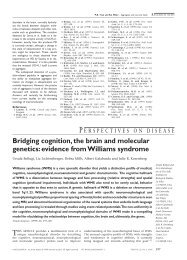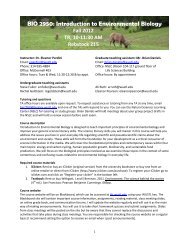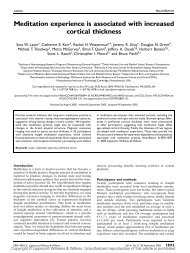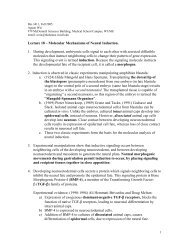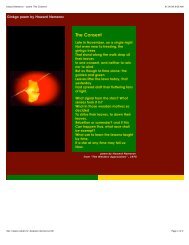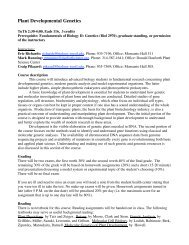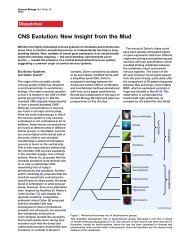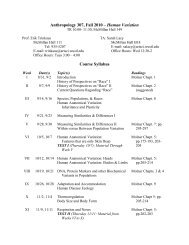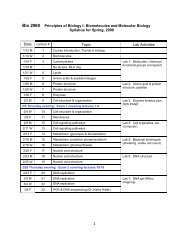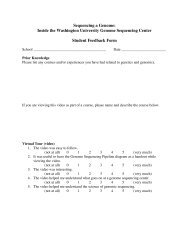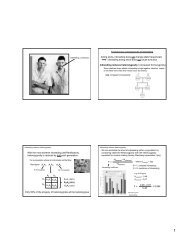Table 8Coalescence Ages <strong>of</strong> the Four Major <strong>Ashkenazi</strong> mtDNA LineagesHg AND SubHgAGE aSD bN r Years j YearsHVS-I:K1a1b1a:16224 16234 16311 46 .09 1,755 .04 87716223 16224 16234 16311 67 .16 3,313 .07 1,506K1a9:16224 16311 5 0 0 .20 4,03616093 16224 16311 36 0 0 .03 561K2a2a:16224 16311 25 .08 1,614 .06 1,142N1b:16145 16176A 16223 56 .04 721 .03 510Coding region:K1a1b1a:Entire branch 14 .36 1,835 .16 821<strong>Ashkenazi</strong> 7 .14 742 .14 742K1a9:Entire branch 6 .33 1,713 .24 1,211<strong>Ashkenazi</strong> 4 .50 2,569 .35 1,816K2a2a:<strong>Ashkenazi</strong> 2 0 0 .50 2,569N1b:<strong>Ashkenazi</strong> 2 0 0 .50 2,569aCoalescence time was calculated by considering one transition betweennucleotides 16090–16365 (HVS-I) equal to 20,180 years (Forsteret al. 1996) and one base substitution between nucleotides 577–16023 (coding region) equal to 5,138 years (Mishmar et al. 2003).bSD <strong>of</strong> the r estimate (j) was calculated as reported elsewhere(Saillard et al. 2000).Figure 3 Most parsimonious tree <strong>of</strong> complete Hg N1b mtDNAsequences. <strong>The</strong> tree encompasses the two complete <strong>Ashkenazi</strong> N1bsequences and one previously published sequence (Maca-Meyer et al.2001). <strong>The</strong> same considerations detailed in figure 1 are relevant here.Nucleotide positions 11928 and 12092 (bold) were examined in allN1b mtDNAs.AcknowledgmentsWe thank the individuals who provided samples for thisstudy, the National Laboratory for the Genetics <strong>of</strong> Israeli Populations,which also provided samples, and Vered Friedmanand Guennady Yudkovsky for technical assistance. This researchwas supported in part by Israeli Science Foundationgrants (to K.S.), the Annie Chutick Endowment and Technion(to K.S.), the Estonian Science Foundation (to E.M. and T.K.),European Union Framework Programme Genemill and Generagrants (to R.V.), the Consiglio Nazionale della Ricerche–Ministrodell’Istruzione dell’Univerita e della Ricerca (CNR-MIUR) Genomica Funzionale-Legge 449/97 (to A.T.), theFondo Investimenti Ricerca di Base 2001 (to A.T.), the ProgettiRicerca Interesse Nazionale 2005 (to A.T.), the National ScienceFoundation (to N.H.), and Programa Operacional Ciência,Tecnologia e Inovação (to A. Amorim).Appendix AMethodsSamplingA total <strong>of</strong> 583 <strong>Ashkenazi</strong> Jewish and 1,111 non-<strong>Ashkenazi</strong>Jewish samples were analyzed for mtDNA Hgspecificmarkers, identifying 186 and 63 samples, respectively,belonging to Hg K (HVS-I data for 565 <strong>of</strong>the <strong>Ashkenazi</strong> samples have been reported elsewhere [Beharet al. 2004]). Of the 186 samples found among <strong>Ashkenazi</strong>Jews and the 63 Hg K samples found among non-<strong>Ashkenazi</strong> Jews, 182 and 62, respectively, were availablefor further genotyping. Next, we identified Hg K samplesin all population sample collections available from thelaboratories in Haifa, Tartu, Pavia, Porto, and Paris, andwe reported only populations in which Hg K sampleswere found and available for further genotyping. Weevaluated a total <strong>of</strong> 11,452 samples from 67 populationsand identified 636 Hg K samples, 545 <strong>of</strong> which wereavailable for further genotyping. Table 5 details the totalnumber <strong>of</strong> samples available from each population, the494 <strong>The</strong> American Journal <strong>of</strong> Human Genetics Volume 78 March 2006 www.ajhg.org
number <strong>of</strong> Hg K samples within each population, thenumber <strong>of</strong> Hg K samples from each population that weretechnically available for genotyping in this study, thereporting laboratory, and the first study in which thesamples were reported (Bermisheva et al. 2002; Beharet al. 2004; Pereira et al. 2004; Quintana-Murci et al.2004). We then examined the same data set <strong>of</strong> Jewishsamples described above for the presence <strong>of</strong> Hg N1bsamples and identified a total <strong>of</strong> 57 and 11 Hg N1bsamples in <strong>Ashkenazi</strong> and non-<strong>Ashkenazi</strong> Jews, respectively.We also reported the results <strong>of</strong> 14 Hg N1b samplesfound in the same Druze, Palestinian, and Bedouin samplesincluded in the sample set described above (table5), and we compared the <strong>Ashkenazi</strong> N1b Hg mtDNAswith the unpublished database <strong>of</strong> 8,644 Caucasian, European,Near and Middle Eastern, and North Africansubjects included in this study and available in Tartu(table 5). All samples reported herein were derived fromblood, buccal swab, or blood cell samples that werecollected with informed consent, in accordance with proceduresapproved by institutional human subjects reviewcommittees in their respective locations. All subjects reportedthe birthplace <strong>of</strong> their mothers, grandmothers,and, in most cases, great-grandmothers.Control-Region SequencingSequences <strong>of</strong> the control region were determined fromposition 16024 to 00300, by use <strong>of</strong> the ABI Prism DyeTerminator cycle-sequencing protocols developed by AppliedBiosystems (Perkin-Elmer). Control-region sequencedata were used to define haplotypes within the Hgs. <strong>The</strong>control-region information reported from Haifa andParis extends from 16024 to 00300. <strong>The</strong> control-regioninformation reported from Tartu spans from 16024 to16400, corresponding to HVS-I. <strong>The</strong> control-region informationreported from Pavia extends from 16024 toat least 00200 and, in most cases, up to 00300. <strong>The</strong>control-region information reported from Porto extendsfrom 16024 to 16365 and from 00072 to 00340. <strong>The</strong>hypervariable positions 16182 and 16183 in HVS-I andthe indels at positions 00309 and 00315 in HVS-II wereexcluded from the analysis (tables 1 and 4).Complete mtDNA SequencingDNA was amplified using 18 primers to yield nineoverlapping fragments, as reported elsewhere (Taylor etal. 2001). After purification, the nine fragments weresequenced by means <strong>of</strong> 56 internal primers to obtain thecomplete mtDNA genome. Sequencing was performedon a 3100 DNA Analyzer (Applied Biosystems), and theresulting sequences were analyzed with the SEQUEN-CHER s<strong>of</strong>tware. Mutations were scored relative to therCRS (Andrews et al. 1999). <strong>The</strong> novel 28 Hg K and 2N1b complete mtDNA sequences reported herein havebeen submitted to GenBank (accession numbersDQ301789–DQ301818). Quality control was assuredas follows: first, each base pair was determined oncewith a forward and once with a reverse primer; second,any ambiguous base call was tested by additional andindependent PCR and sequencing reactions; and third,all sequences were examined by two independentinvestigators.Hg LabelingAll Hg K samples reported herein harbored the diagnosticmarker G9055A, as confirmed by the RFLPreaction 9052HaeII. Diagnostic markers for genotypingsubclades <strong>of</strong> Hg K were selected on the basis <strong>of</strong> theanalyses <strong>of</strong> the complete mtDNA sequences. Positions295, 497, 498, 1189, 4561, 7927, 8697, 8703, 8790,9254, 9647, 9716, 10398, 11025, 11914, 13117,11470, 11485, 15924, 10978, and 12954 were obtainedby direct sequencing. Positions 1189, 5913, 9716,10398, and 11914 were obtained by direct sequencingor by means <strong>of</strong> RFLPs 1186RsaI, 5913HaeIII,9714BsaI, 10398DdeI, and 11914TaiI or11911HpyCH4IV, respectively. All Hg N1b samplesreported herein harbored the diagnostic markerT10238C, as confirmed by 10237HphI. Two diagnosticpositions, 11928 and 12092, derived from thecomplete mtDNA sequences analysis <strong>of</strong> the two Hg N1bsamples, were examined by direct sequencing in all Jewish,Druze, Palestinian, and Bedouin samples.NomenclatureWe followed a consensus Hg nomenclature scheme(Richards et al. 1998). Numbers 1–16569 refer to theposition <strong>of</strong> the mutation in the rCRS (Andrews et al.1999). We use the term “lineage” to denote a cluster <strong>of</strong>related, evolving haplotypes within an Hg. Note thathaplotypes and lineages can relate to HVS-I, to the controlregion, or to the complete mtDNA sequence data.Nomenclature within Hg K has been the subject <strong>of</strong> someambiguity because <strong>of</strong> the recycling <strong>of</strong> the designation“K1a” (Herrnstadt et al. 2002; Palanichamy et al. 2004).We followed the definitions <strong>of</strong> both publications for“K1” and “K2.” We followed Palanichamy et al. (2004)for the definitions <strong>of</strong> “K1a,” “K1a1,” “K1a2,” “K1b,”“K1c,” and “K2a” and corrected in this article a fewinaccuracies reported for the samples labeled “SF#153”and “CH#365.” Herrnstadt et al. (2002) used the designation<strong>of</strong> “K1a” for one subHg <strong>of</strong> K. To avoid confusionand because this lineage was found to be highlyimportant in the current study, we specifically note thatwe assigned to this lineage the more detailed designation“K1a1b1a.”www.ajhg.org Behar et al.: <strong>Portrait</strong> <strong>of</strong> a Founder Event 495



